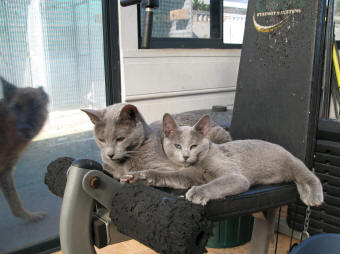|
FLEAS
Fleas are the most common problem that pet
owners have. Few pests can arouse anger in
people as easily as fleas. Their bites are
painful and they are hard to catch and squash.
They cause extreme discomfort to many pets. The
common species of flea found on both dogs and
cats is the Cat Flea (Ctenocephalides felis).
The Flea Life Cycle
Adult fleas represent only two percent
of the flea population. The other ninety eight
percent of the population are found in the
animal's surroundings.
Adult fleas feed and mate within 24 hours. They
then lay eggs 36-48 hours after that. The female
flea can lay up to 500 eggs, usually in batches
of 5-15. Adult fleas live for up to four months.
They are laterally compressed bodies, their legs
are adapted for jumping and they have piercing
and sucking mouthparts. The newly hatched flea
is small and black, feeding for two to three
days before becoming brown and fully engorged.
Unfed adult fleas may live up to 3 months in
high humidity and 9-14 days in dry conditions.
Flea eggs are small and shiny and are mostly
laid when pets are still or asleep. The eggs
fall out of the animal's coat and into the
environment into predictable areas, such as
bedding, carpets, furniture etc. They normally
hatch into larvae within 2 to 14 days. Vacuuming
can remove up to 90% of flea eggs.
Flea larvae are legless but highly mobile. They
move away from the light and down into the
darker areas such as carpet pile and soil and
sand. They eat organic matter including flea
faeces, crumbs, human and animal skin scales
etc. When
disturbed, larvae curl around carpet fibres
therefore
vacuuming removes only 15-27% of larvae. Indoors
they can be found in sheltered areas especially
in carpets and mats away from traffic. Outdoors
larvae can be found in shaded moist spots where
the animal would normally rest. Larvae pupate
usually within 9-15 days in ideal conditions.
Pupae are sticky silken cocoons. They attract
dust and debris from their surroundings making
them difficult to detect.
Pupae are highly resistant to chemicals and may
lay dormant for up to two years if left
undisturbed. Vibrations, pressure, warm
temperatures and carbon dioxide trigger
emergence of the adult flea.
MICRO CHIPPING
EVER
LOST A PET?
TROVAN MICROCHIP IMPLANTS:
Your best chance for reunion. Will your pet
become another unclaimed stray??
Many dogs and cats "stray" each year, and
are needlessly put to sleep because their
identification tags or collars are lost, damaged
or simply not worn.
By law, all dogs must be registered with your
local municipality and should carry an
identification tag or collar. Even if your dog
carries a current registration tag, on weekends,
public holidays or out of normal business hours,
tracing YOU, the owner, can be difficult.
Now there is a way of identifying all your pets
(dogs, cats, birds, horses, fish etc.)
permanently, 24 hours a day, 7 days a week.
The answer - the identity tag, silicon microchip
implant.
HOW DOES IT WORK?
Your veterinarian can implant this tiny
Trovan "chip" (size of a rice grain), painlessly
into your pet without the need for clipping,
sedation or anaesthetic. It is often performed
in consultation along with other routine
procedures such as vaccination.
The chip carries a unique number that is linked
to your name, phone number and pet description
at Central Animal Records. When lost, your pet
is simply scanned with a special electronic
device that displays on its screen, the
microchip number. This number is then quoted to
the Central Animal Records office at any time,
24 hours a day, 7 days a week on a toll free
number. After quoting a special security number
to the computer operator, your name and phone
number can be found and the happy reunion
effected!
Ask your vet for details, the next time you are
there.
|

Zena & Tristan -
mother and son having a well earned rest
|





















